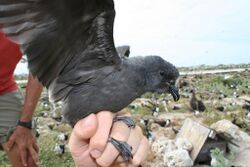Biology:Oceanodroma
| Oceanodroma | |
|---|---|

| |
| Tristram's storm petrel (Oceanodroma tristrami) | |
| Scientific classification | |
| Domain: | Eukaryota |
| Kingdom: | Animalia |
| Phylum: | Chordata |
| Class: | Aves |
| Order: | Procellariiformes |
| Family: | Hydrobatidae |
| Subfamily: | Hydrobatinae |
| Genus: | Oceanodroma L. Reichenbach, 1853 |
| Species | |
|
See text. | |
Oceanodroma is a genus of storm petrels. The genus name is from Ancient Greek okeanos, "ocean" and dromos, "runner".[1]
One species, the Guadalupe storm petrel (O. macrodactyla), is possibly extinct.
In 2010, the International Ornithological Congress (IOC) added the Cape Verde storm petrel (O. jabejabe) to their list of accepted species (AS) splits, following Bolton et al. 2007. This species was split from the band-rumped storm petrel (O. castro).
In 2016, the IOC added Townsend's storm petrel (O. socorroensis) and Ainley's storm petrel (O. cheimomnestes) to their list of AS splits, following Howell 2012. These species were split from Leach's storm petrel (O. leucorhoa).
Species
The genus contains 17 species:[2]
- Leach's storm petrel, O. leucorhoa
- Townsend's storm petrel, O. socorroensis
- Ainley's storm petrel, O. cheimomnestes
- Matsudaira's storm petrel, O. matsudairae
- Least storm petrel, O. microsoma
- Wedge-rumped storm petrel, O. tethys
- Band-rumped storm petrel, O. castro
- Cape Verde storm petrel, O. jabejabe
- Monteiro's storm petrel, O. monteiroi
- Swinhoe's storm petrel, O. monorhis
- Guadalupe storm petrel, O. macrodactyla (possibly extinct)
- Tristram's storm petrel, O. tristrami
- Markham's storm petrel, O. markhami
- Black storm petrel, O. melania
- Ashy storm petrel, O. homochroa
- Hornby's storm petrel or ringed storm petrel, O. hornbyi
- Fork-tailed storm petrel, O. furcata
Taxonomy and phylogeny
The genus Oceanodroma was erected in 1853 by the German naturalist Ludwig Reichenbach with the fork-tailed storm petrel (Oceanodroma furcata) as the type species.[3][4] Phylogenetic analyses have found that Oceanodroma paraphyletic with respect to Hydrobates.[5][6] As a result some authorities have transferred all Oceanodroma species to Hydrobates, although other authorities continue to recognise the two genera.[citation needed]
The following cladogram shows the results of the phylogenetic analysis by Wallace et al (2017), who use Hydrobates for all species.[6]
| Oceanodroma |
| ||||||||||||||||||||||||||||||||||||||||||||||||||||||||||||||||||||||||||||||
References
- ↑ Jobling, James A (2010). The Helm Dictionary of Scientific Bird Names. London: Christopher Helm. p. 279. ISBN 978-1-4081-2501-4. https://archive.org/details/Helm_Dictionary_of_Scientific_Bird_Names_by_James_A._Jobling.
- ↑ Gill, Frank; Donsker, David; Rasmussen, Pamela, eds (2020). "Kagu, sunbittern, tropicbirds, loons, penguins, petrels". IOC World Bird List Version 10.1. International Ornithologists' Union. https://www.worldbirdnames.org/bow/loons/. Retrieved 7 June 2020.
- ↑ Reichenbach, Ludwig (1853) (in German). Handbuch der speciellen Ornithologie. Leipzig: Friedrich Hofmeister. p. iv. https://www.biodiversitylibrary.org/page/47618634.
- ↑ Mayr, Ernst; Cottrell, G. William, eds (1979). Check-List of Birds of the World. Volume 1 (2nd ed.). Cambridge, Massachusetts: Museum of Comparative Zoology. p. 112. https://www.biodiversitylibrary.org/page/16108752.
- ↑ Robertson, Bruce C.; Stephenson, Brent M.; Goldstien, Sharyn J. (2011). "When rediscovery is not enough: Taxonomic uncertainty hinders conservation of a critically endangered bird". Molecular Phylogenetics and Evolution 61 (3): 949–952. doi:10.1016/j.ympev.2011.08.001.
- ↑ 6.0 6.1 Wallace, S.J.; Morris-Pocock, J.A.; González-Solís, J.; Quillfeldt, P.; Friesen, V.L. (2017). "A phylogenetic test of sympatric speciation in the Hydrobatinae (Aves: Procellariiformes)". Molecular Phylogenetics and Evolution 107: 39–47. doi:10.1016/j.ympev.2016.09.025.
Wikidata ☰ Q603287 entry

